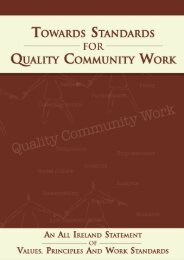Intercultural Education in the Post-Primary School - National Council ...
Intercultural Education in the Post-Primary School - National Council ...
Intercultural Education in the Post-Primary School - National Council ...
You also want an ePaper? Increase the reach of your titles
YUMPU automatically turns print PDFs into web optimized ePapers that Google loves.
CONFLICT AND CONFLICT RESOLUTIONSometimes <strong>the</strong> differences between peoplebecome a source of conflict. Differentcultural traditions, for example, may br<strong>in</strong>gpeople <strong>in</strong>to conflict with each o<strong>the</strong>r. Peoplemay come <strong>in</strong>to conflict with each o<strong>the</strong>rbecause of a perceived clash of rights andresponsibilities. <strong>Intercultural</strong> education canequip people with <strong>the</strong> skills to workthrough such conflicts and arrive at aresolution. These skills will be useful andnecessary to all students even if <strong>the</strong>y donot regularly come <strong>in</strong>to contact withmembers of different ethnic groups.Conflict should be seen as natural andnormal and can be viewed as anopportunity to arrive at solutions andbr<strong>in</strong>g about positive change. Certa<strong>in</strong>pr<strong>in</strong>ciples should underlie approaches toconflict, whe<strong>the</strong>r <strong>the</strong> conflict is<strong>in</strong>terpersonal, <strong>in</strong>ter-community or political.These <strong>in</strong>clude <strong>the</strong> follow<strong>in</strong>g:• Conflict should not be avoided. S<strong>in</strong>ceconflict is normal it provides anopportunity to build someth<strong>in</strong>g positive.We should focus on equipp<strong>in</strong>g peoplewith <strong>the</strong> ability to negotiate throughconflicts ra<strong>the</strong>r than avoid<strong>in</strong>g <strong>the</strong>m.• Separate people from <strong>the</strong> problem. In aconflict situation <strong>the</strong>re can be strongemotions, communication breakdownand differ<strong>in</strong>g perceptions of <strong>the</strong> facts or<strong>the</strong> importance of facts. These issuesneed to be dealt with <strong>in</strong> <strong>the</strong>mselves, andshould not be by-passed through oneside or both ga<strong>in</strong><strong>in</strong>g concessions. Onedoes not need to like someone to cometo agreement with <strong>the</strong>m, but one doesneed to be able to talk to and listen to<strong>the</strong>m, and to be able to see th<strong>in</strong>gs from<strong>the</strong>ir po<strong>in</strong>t of view.• Focus on <strong>in</strong>terests, not positions. Ra<strong>the</strong>rthan focus on what people are look<strong>in</strong>gfor, explore why <strong>the</strong>y want it. Beh<strong>in</strong>doppos<strong>in</strong>g positions may lie a range ofshared and compatible <strong>in</strong>terests onwhich a reso• Invent options for mutual ga<strong>in</strong>. Look ata range of possible solutions, without<strong>the</strong> pressure of hav<strong>in</strong>g to decide what ispractical or doable. Look for a varietyof possibilities ra<strong>the</strong>r than a s<strong>in</strong>gleanswer, and do not rush to judgement.There are many models of conflictresolution based on <strong>the</strong>se pr<strong>in</strong>ciples.Clearly, such approaches to negotiat<strong>in</strong>gresolutions to conflict will only work ifboth partners are will<strong>in</strong>g and able toengage <strong>in</strong> <strong>the</strong> process. When people are notskilled <strong>in</strong> <strong>the</strong> process of conflictnegotiation <strong>the</strong>y may need a facilitator toaid <strong>the</strong> process of resolution. However <strong>the</strong>focus should be on develop<strong>in</strong>g skills so thatpeople can manage <strong>the</strong>ir own conflicts.For children <strong>in</strong> <strong>the</strong> early years of primary,peace skills are built through <strong>the</strong>development of a capacity for cooperation,for shar<strong>in</strong>g, for identify<strong>in</strong>gpotential consequences of <strong>the</strong>ir actions andthrough develop<strong>in</strong>g a language with whichto name and express <strong>the</strong>ir feel<strong>in</strong>gs.Build<strong>in</strong>g on this, middle and upper primaryclasses will develop a deeper capacity tocope with <strong>the</strong>ir feel<strong>in</strong>gs, as well as acapacity to compromise and accept groupdecisions.At post-primary level, students should nowbe able to discuss and express emotions <strong>in</strong>a non-threaten<strong>in</strong>g way, listen actively toboth concepts and emotions, negotiatewith each o<strong>the</strong>r and beg<strong>in</strong> <strong>the</strong> process ofpractic<strong>in</strong>g peaceful resolution of conflicts.60<strong>Intercultural</strong> <strong>Education</strong> <strong>in</strong> <strong>the</strong> <strong>Post</strong>-<strong>Primary</strong> <strong>School</strong>
















